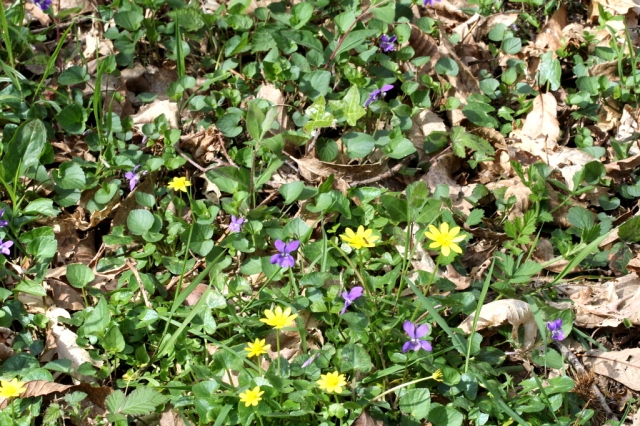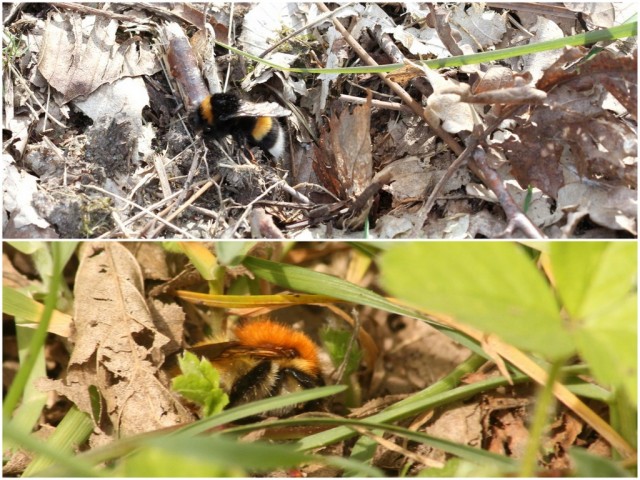Back from the UK, I was curious to find out how all the rain that has fallen this year has affected the woods around the house. Before I left some of the paths were still very muddy but the soil dries up quickly here.
The wild anemones carpeted the ground under the trees still not fully in leaf. They are more plentiful than last year and present in places I had never noticed them before. They are mainly white and single but I enjoy finding the variants of other colours and the double variant.
They are early this year and I would expect to find them at the end of April (See http://wp.me/p2cvii-6F ).
The violets and lesser celandine stood out on the edge of the paths.
These are not the perfumed violets that I find in some places but they are just as beautiful.
The yellow butterfly (maybe a Brimstone) seemed happy to accept the nectar, perfume or not.
Always on the outlook for bees, I notice other things and I frequently come across the Violet Oil Beetle (Meloe violaceus ). It is not a friend of solitary bees as its larvae find their way onto flowers and hitch a lift on the solitary bees that they encounter so that they can enter their nests. The larvae then proceed to consume eggs, nectar and pollen.
I had never seen the beetle mating before and I was surprised that the female could scuttle through the leaves just as quickly while dragging the male behind her. He did his best to stay upright but he often lost balance as it cannot be easy walking backwards with six legs that usually go frontwards.
I also noticed a lot of little flies on the female’s back and I have found out that they could be attracted to fluids that she exudes or they extract from her haemolymph. This is an oily substance called cantharadin which can blister human skin. This substance is produced by other beetles like the more well known Spanish fly (Lytta vesicatoria).
The Pulmonaria is abundant this year, usually with its mix of blue and pink flowerlets. I read some interesting comments on colour change and pollination of flowers (more particularly on fruit trees) in Coloured clues; Mossy Mulch; and Easter Eggs at The Garden Impressionists.
Unfortunately, there are also a lot of bee flies on the spring flowers. These flies are also parasites of solitary bees laying their eggs on flowers or near the nests of the solitary bees.
It’s not all bad news for the bees as the Asphodel are starting to flower and it has been a mild winter with lots of rain which has suited them well.
The Lady’s smock (Cardamine pratensis) seems early and is more abundant.
The Greater Stitchwort, Stellaria holostea is everywhere and is attracting the attention of an Andrena bee here, probably Andrena Willkella.
Everything is fresh and pushing through like the fern fronds unfurling.
This is a time of activity and as I walk I hear the bumble bees, not just in the flowers but searching. They are searching for just the right place to build their nest. I often follow them as they explore and vanish into holes but they always return to continue their search, never seeming to find just the right place.














You’ve just identified an insect for me. A couple of years ago we saw a pair of beetles that look very much like that doing very much the same thing on a dock out in New Hampshire. Lovely flower photos, too.
LikeLike
Beauty and the beast? The beetle has a very definite violet shine and the antenna are very knobbly but don’t pick it up! Amelia
LikeLike
A great read, and very informative.
. . . FYI, it’s snowing here.
LikeLike
The US is getting more than its share of snow and ice this – should I say winter or spring? Amelia
LikeLike
Great post and lovely photographs, Mother nature dealt a strange card with the eating habits of oil beetle larvae.
LikeLike
It’s not only its eating habits that are strange. Take a look at its face https://afrenchgarden.wordpress.com/2012/04/09/weeding-tricked-again/ That was the first time I saw one. Amelia
LikeLike
I never knew that anemone blossoms varied that much. I wonder if they are wild or cultivated? I’ll have to take a closer look when ours bloom. It’s nice to see spring happening.
LikeLike
They are wild and you do get natural variants. The actual plants are a lot more fragile and hug the ground more than the cultivated varieties. They are in the sun in clearings just now but disappear soon as the trees get their leaves. Amelia
LikeLike
You had a mild winter and then an early spring. I wonder if that means it will be a long, hot summer in your area. I envy all the spring flowers (and insects) that you’re seeing. It’s snowing again here today.
LikeLike
The US has had the opposite from us in weather conditions this year. It’s hard for me to imagine you still in snow and ice. Amelia
LikeLike
Lovely to take a “walk” through your woodlands. Thanks for the great photos.
LikeLike
It’s good to see what is happening on somebody else’s “patch”. Amelia
LikeLike
Lovely to see what is happening in your garden. I have just divided my pulmonaria. Hopefully they will be happy about that and give me lots more flowers this spring.
LikeLike
I’m still planting more Pulmonaria in the very back of the garden, I look forward to having to divide it. Amelia
LikeLike
Reblogged this on White Lies.
LikeLike
I’ve never seen a double anemone in the wild, so must keep my eyes open. I have also seen a lot of bee flies this spring, but more bees and bumble bees than ever before! I think you are a little ahead of us, and we are at least 3 weeks ahead of last year… no sign of the ferns here yet, but everything is happening so rapidly it can only be a matter of days now. Lovely post Amelia!
LikeLike
P.S. Your link on colour change and pollination is really interesting – thanks for including that!
LikeLike
Thank you, Spring is early this year, for Europe at least. Amelia
LikeLike
Hello A,
What a lovely spring post and great photos. Suddenly France is looking way ahead of us again. And fabulous to get all those native wood anemones.
I must admit that I’ve sometimes followed bumblebees and never been convinced that I’ve seen them enter a nest…all the nests I’ve ever discovered have been by chance, disturbing them. Thanks for the link as well, and glad to see the bee fly…although they’ve a bit of a menacing life cycle, I think they’re such amazing insects with their enormously long tongues and legs,
BW
Julian
LikeLike
Dave Goulson of the Bumblebee Conservation Trust says that to find bumblebee nests he takes a deck chair and a gin and tonic on a sunny day and watches. I’ve only noticed nests by the activity of the workers in the summer but I can’t resist keeping my eyes on the Queens. Amelia
LikeLike
The Asphodels are flowering here too; I love seeing them, they remind me of DH Lawrence and his book Etruscan Places as the first time I saw them flowering was at an Etruscan tomb site near here and he described them exactly as I saw them.
LikeLike
Beautiful flowers, they look so majestic.
LikeLike
Nice bee shots, Amelia. That Violet Oil Beetle (Meloe violaceus ) looks a little like a Snail-eating Ground beetle,(Scaphinotus angusticollis), which I’ve seen here.
I’ve seen the bumblebees flying low too, looking for a place to nest. It’ll probably end up in my shop wall where they really prefer to nest. 🙂
LikeLike
I hope some bumblebees will nest in the garden this year. The nests are not easy to spot until later in the year when there are a lot of workers going to and fro. Amelia
LikeLike
How lovely. Amusing about the female oil beetle dragging her mate behind her!
The bumble bee queens I see searching never seem satisfied either. They must be very particular about where they build their nests.
LikeLike
They are fascinating creatures, I just wish they were vegetarian. Amelia
LikeLike
Joyeux printemps!
LikeLike
Lots of favourites, Amelia – though I don’t have any asphodels here. Gorgeous and look like orchids. I’ve only just introduced some pulmonaria into the gardens – and about time too. Dave
LikeLike
I wasn’t all that keen on Pulmonaria at first, but I’ve become quite a fan now and I am looking to see if I can find some different colours. Amelia
LikeLike
Lovely spring!
LikeLike
It’s the warmest, earliest spring I’ve had since coming to live in France. Amelia
LikeLike